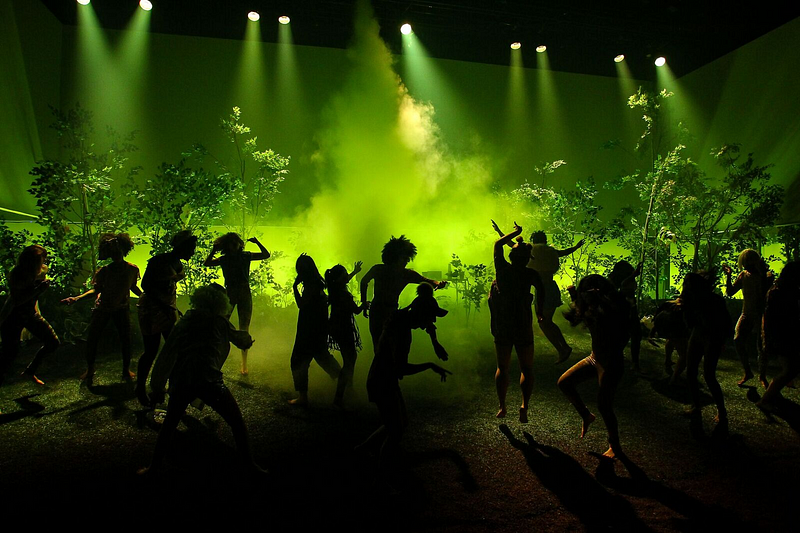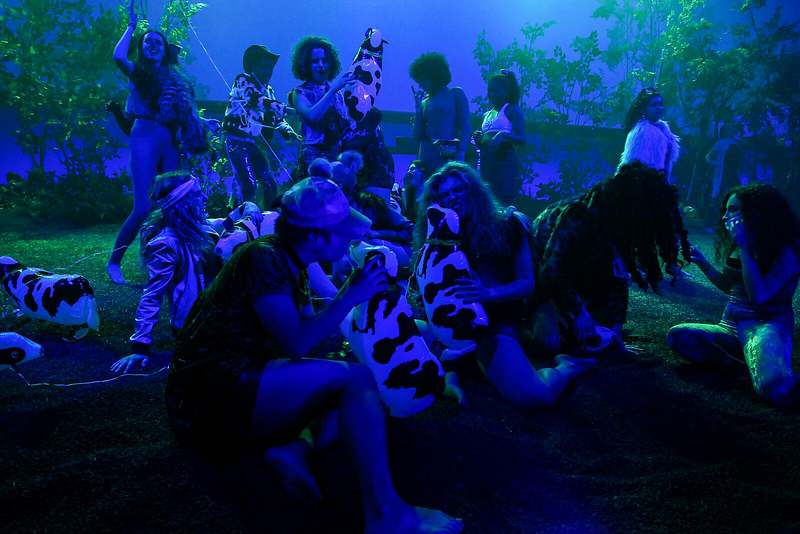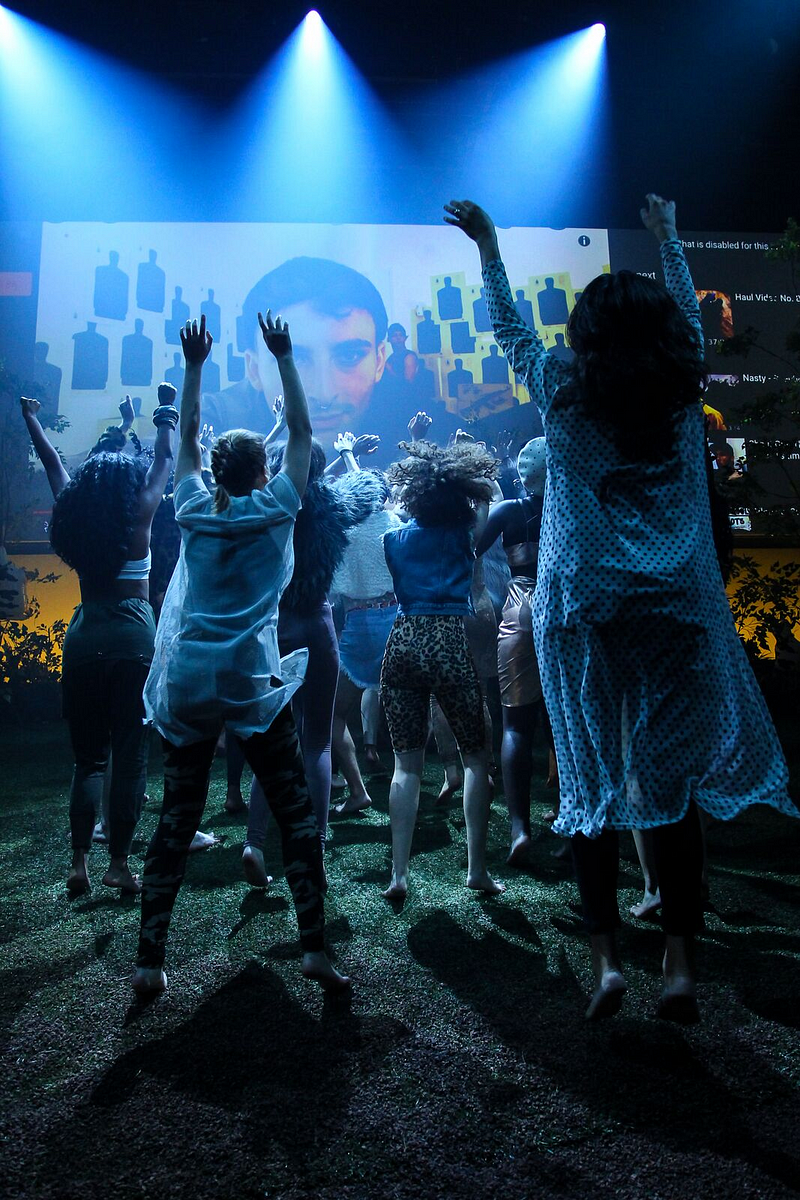Review: Gurls at the Lewis Center for the Arts

Photo by Larry Levanti
In the very first rehearsal for Gurls, I and nineteen other ensemble members were introduced to the enigmatic choreographer for the production, Raja Feather Kelly, a slender man whose lanky stature is belied by his jovial, impossible-to-ignore presence. Sitting cross-legged in a semi-circle, Raja presented to all of us the heart and soul of the production with a question — why do we dance? Silence hanging in the air, we all looked at each other, waiting for someone else to take the bait. Raja laughed and said, “All right, Princeton. Lemme teach you something.”
The answer, as unexpected as it is simple, was enough to make us all feel a little more than foolish: we dance because we are 60% water. We love songs with a deep, thumping bass, because the resonance forces the water in our bodies to pulsate along with the beat. We love feeling the vibrations cut through us and seeing where we are taken.
Letting one’s mind be carried away by sensation was a pivotal idea explored in Gurls, an adaptation of Euripides’ The Bacchae written and directed by Princeton alumni Brandon Jacob-Jenkins and Lileana Blain-Cruz respectively. The modern-day version adheres closely to the original with a few exceptions: Dionysus is now a DJ, blasting remixed music pumped full of techno-beats; Pentheus is a trigger-happy YouTuber, desperate to become the new town sheriff; and, most importantly, the transfixed women on the mountainside are now a varied and dynamic group, desperate to forget their troubles in a makeshift dance club. Sporting a frizzy wig, lace booty shorts, and a leopard print coat, I played as one of these bewitched girls in one of the most intense performance experiences of my life.
My easiest task as a chorus member was to create a believable party scene. However, as the play progresses and circumstances practically sprint downhill, the ensemble has to accomplish an undertaking a little more difficult and much more subtle. With every play, there is a gap between the audience and the performers, especially in a show like Gurls which requires a great deal of suspension of disbelief. When Theo, the new iteration of Pentheus, is murdered by his mother, the audience had to feel as though they were complicit, as if they were at fault for letting the party turn into a tribalistic scene fraught with danger. Truly engaging the audience means the performers cannot rely on just visual and aural media — we had to invoke a stronger force for arresting the audience: kinesthetic empathy.
Everyone I’ve talked to who has seen the show has commented on how they were tired just watching us. The exhaustion, fatigue, and weariness we felt as dancers were feelings shared by everyone in the room. This communal sensation is the best example for kinesthetic empathy: in spite of the clear line between who was performing and who was watching, everyone in the theatre felt the animalistic urges which emerge in the show’s climax to hunt and kill. The physical immersion of the audience in this strange, dark world made it all the more horrifying when the lights come up, the music stops, and we realize how far we’ve all gone.
In order to pull the audience with us down the path to hedonistic insanity, we had to create an enticing and free environment — a space demarcated by its lack of boundaries. Like a real-life club, our dance moves conjured the image of a jungle which the audience would want to explore. The curiosity inspired by the mystery intrinsic to our wildness was the tool for roping in the onlookers and making them want to join us. Essentially, to reach the audience members, we had to be like the water in their bodies: our movement had to make the audience want to come and gambol with us for a time.
On the face of it, the show was exhausting — I would traipse home every night, burdened with two different kinds of fatigue. The first was the simple physical weariness that comes with dancing for hours straight, but the other was a little more complicated. Delving repeatedly into the mad violence that inhabits all humans was difficult to say the least. However, what kept me going was the knowledge that these growing pains were what made the show a joyous thing. Ultimately, our actions would provide the audience with the entrance into what was undoubtedly an unparalleled experience.
The use of dance as a tool to connect with the audience is hardly innovative. Yet, with the slow-burning genius of Raja Feather Kelly, our movement became more than just an interesting component of the show. Choreography was our medium to inculcate the audience slowly into a terrible environment. We were able to explore what it means when our playfulness delves into a place lacking any form of humanity. Therein lies the timeless beauty of The Bacchae — no matter the time or place, audiences around the world understand what means to be swept away by sensation. No matter how horrifying it may be, the show remains of interest because it lets us look at the taboos of our society — the dreadful, yet compelling sensations we experience when the vibrations of the music we wrap ourselves in threaten to shake us apart. — Andrew Tye ‘21

Photo by Larry Levanti
In traditional ancient Greek tragedy, nothing is as it seems. The chorus speaks in riddling verse, singing the enigmas of the story through many mouths. The plot often somersaults down twists and turns, complete with surprising twists, before landing at the final denouement. Three actors, disguised by large masks, alternating play all of the main characters — in short, there are always layers to work through. You don’t really know what you’re watching until it smacks you upside the face.
The Lewis Center’s recent production of Gurls, a modern adaptation of Euripedes’ The Bacchae, throws this tradition out the window. What stunned me when I saw the show was how exposed everything was. In the small theater, Deon (Dionysus) practically whispers his plot to take down the non-believer Theo (Pentheus) into the audience’s ears. Every facial expression, and contorting muscle, of each chorus member is harshly exposed under the jewel-toned lighting. Many of the scenes between the main characters were projected larger-than-life onto the wall behind the stage, allowing the audience to see every facial tic and twitch exhibited by the anxious Theo. In The Bacchae, Pentheus puts up a front in every scene, and does not allow the audience to see his insecurity until it is too late. In Gurls though, this side of Theo is evident from the beginning.
The most striking example of the exposed nature of Gurls comes at Theo’s death. (2500-year-old spoiler alert!) While in the original, Pentheus is killed offstage, having been dismembered by lions, in Gurls, he is brutally massacred by every member of the cast. They each draw a gun, and fire repeatedly into Theo, who has been equipped with a disturbingly-real blood rig. Something like this would never have happened in ancient Greek tragedy — showing death on stage is strictly forbidden. But in Gurls, the visceral visibility of this death is its power. — Sylvie Thode ‘20

Photo by Larry Levanti